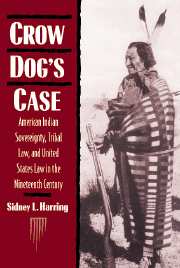 Crow Dog's Case
Crow Dog's Case Published online by Cambridge University Press: 23 September 2009
The legal history of Indian–white relations in Alaska is substantially unrelated to parallel developments in the rest of the United States. While twentieth century federal Indian law often applies to Alaska in the same manner as it does to the rest of the country, nineteenth-century law did not. In fact, the major nineteenth-century federal Indian law cases had little impact in Alaska; few cases arose, both because courts came to Alaska only in 1884 and because there were so few whites. Moreover, no treaties were made with Alaskan natives, and many provisions of the Indian Trade and Intercourse Acts did not govern trade between whites and Alaska's tribes. In the nineteenth century, Alaskan natives lived under the same law as Alaskan whites. They were denied special status, either as tribal sovereigns or as wards dependent on federal protection. This reflected a deliberate decision by local whites, deferred to by federal courts and officials, who either desired to avoid the problems of the Indian law that existed in the rest of the United States or were simply unconcerned about Alaska because of its remoteness.
In order to provide a better understanding of both the history of federal Indian law and Alaska's unique situation, this chapter focuses on the legal incorporation of the Tlingit into U.S. law. The Tlingit occupied one thousand miles of coastline along the panhandle of southeast Alaska and bore most of the early impact of U.S. colonialism.
To save this book to your Kindle, first ensure [email protected] is added to your Approved Personal Document E-mail List under your Personal Document Settings on the Manage Your Content and Devices page of your Amazon account. Then enter the ‘name’ part of your Kindle email address below. Find out more about saving to your Kindle.
Note you can select to save to either the @free.kindle.com or @kindle.com variations. ‘@free.kindle.com’ emails are free but can only be saved to your device when it is connected to wi-fi. ‘@kindle.com’ emails can be delivered even when you are not connected to wi-fi, but note that service fees apply.
Find out more about the Kindle Personal Document Service.
To save content items to your account, please confirm that you agree to abide by our usage policies. If this is the first time you use this feature, you will be asked to authorise Cambridge Core to connect with your account. Find out more about saving content to Dropbox.
To save content items to your account, please confirm that you agree to abide by our usage policies. If this is the first time you use this feature, you will be asked to authorise Cambridge Core to connect with your account. Find out more about saving content to Google Drive.